Dimensions of Thermal Inequity: Neighborhood Social Demographics and Urban Heat in the Southwestern U.S.
Abstract
1. Introduction
2. Materials and Methods
2.1. Data Acquisition
2.2. Data Processing
2.3. Thermal Inequity Analysis
3. Results and Discussion
California
4. Conclusions
Author Contributions
Funding
Institutional Review Board Statement
Informed Consent Statement
Data Availability Statement
Conflicts of Interest
Appendix A
| Model | All 20 Metro (R2) | California (R2) | Non-California (R2) |
|---|---|---|---|
| Hot Day and Income | −2.34(0.87) | −2.96 (0.72) | −1.51 (0.07) |
| Average Day and Income | −2.27 (0.91) | −3.28 (0.11) | −1.89 (0.09) |
| Night and Income | −0.90 (0.67) | −0.91 (0.24) | −0.79 (0.90) |
| Hot Day and Latinx | 3.80 (0.87) | 6.41(0.04) | 2.92 (0.06) |
| Average Day and Latinx | 5.38 (0.88) | 6.05 (0.08) | 3.22 (0.23) |
| Night and Latinx | 2.37 (0.69) | 3.03 (0.06) | 1.08 (0.05) |
| Hot Day and Black | 2.91 (0.84) | 3.52 (0.67) | 1.81 (0.93) |
| Average Day and Black | 3.06 (0.86) | 3.55 (0.03) | 1.89 (0.02) |
| Night and Black | −0.16(0.69) | −0.76 (0.05) | −1.12 (0.00) |
| Metro | Extreme Heat | Average Heat | Nighttime |
|---|---|---|---|
| Albuquerque | 26.9–38.2 °C | 23.3–33.2 °C | 17.8–23.2 °C |
| 80.7–100.4 °F | 73.4–92 °F | 64–74.1 °F | |
| Austin | 30.2–36.9 °C | 22.4–33.3 °C | 11.8–19.8 °C |
| 86.4–98.4 °F | 72.4–92 °F | 53.3–67.7 °F | |
| Bakersfield | 41.6–50.1 °C | 32.7–43.9 °C | 22.2–26.1 °C |
| 106.9–122.2 °F | 90.8–111 °F | 71.2–79 °F | |
| Dallas | 23.3–37.2 °C | 25.2–33.9 °C | Not Available |
| 73.8–98.9 °F | 77.4–93 °F | ||
| Denver | 30.2–41.9 °C | 21.5–39.4 °C | 8.7–14.9 °C |
| 86.4–107.4 °F | 70.7–102.9 °F | 47.7–58.9 °F | |
| El Paso | 37.3–48.9 °C | 35–46.2 °C | 22.4–30.4 °C |
| 99.1–120 °F | 95–115.1 °F | 72.4–86.7 °F | |
| Fresno | 38.3–47 °C | 33.4–42.2 °C | 20.8–25.6 °C |
| 100.9–116.6 °F | 92.2–108 °F | 69.4–78 °F | |
| Houston | 25.9–38.4 °C | 21.8–35.7 °C | 22.8–26.6 °C |
| 78.6–101.2 °F | 71.3–96.3 °F | 73–79.8 °F | |
| Inland Empire | 36–47.8 °C | 28.2–42.8 °C | 18.6–24.7 °C |
| 97.5–118 °F | 82.7–109 °F | 65.4–76.5 °F | |
| Las Vegas | 37.4–48.2 °C | 37.3–45.6 °C | 20.7–27.9 °C |
| 99.3–118.7°F | 98.5–114.4 °F | 69.2–82.3 °F | |
| Los Angeles | 27.2–42.2 °C | 25.6–40.7 °C | 13.7–21.2 °C |
| 81–107.9 °F | 78.2–105.3 °F | 56.6–70.1 °F | |
| Palm Springs | 40.7–49.5 °C | 37.9–46.7 °C | 23.3–28.5 °C |
| 105.2–121°F | 100.3–116 °F | 73.7–83.3 °F | |
| Phoenix | 37.8–49.5 °C | 36.4–47.1 °C | 23.6–32.1 °C |
| 101.1–121.1°F | 97.5–116.7 °F | 74.5–89.8 °F | |
| Reno | 33.1–48.4 °C | 26.1–39.1 °C | 13–20.7 °C |
| 91.5–119.1 °F | 79–102.3 °F | 55.4–69.2 °F | |
| Sacramento | 34.3–47.2 °C | 27.7–38.4 °C | 14.2–17.2 °C |
| 93.7–117.1 °F | 81.9–101.2 °F | 57.6–62.9 °F | |
| Salt Lake City | 30.1–43.7 °C | 25.2–38.7 °C | 8.7–21.8 °C |
| 86.2–110.6 °F | 77.3–101.6 °F | 47.6–71.2 °F | |
| San Antonio | 30.2–36.5 °C | 24.1–32.6 °C | 18.3–21.4 °C |
| 86.3–97.7 °F | 75.4–90.6 °F | 65–70.5 °F | |
| San Diego | 27.3–43.5 °C | 24.3–37.7 °C | 16.3–21.8 °C |
| 81.1–110.3 °F | 75.8–99.8 °F | 61.4–71.2 °F | |
| San Jose | 35–46.6 °C | 24.8–36.2 °C | 15–19.6 °C |
| 95–115.8 °F | 76.7–97.2 °F | 59–67.3 °F | |
| Tucson | 36.7–43.8 °C | 30.8–40.2 °C | 22.7–27.1 °C |
| 98–110.8 °F | 87.4–104.4 °F | 72.8–80.8 °F |
References
- Hess, J.J.; Eidson, M.; Tlumak, J.E.; Raab, K.K.; George, L. An evidence-based public health approach to climate change adaptation. Environ. Health Perspect. 2014, 122, 1177–1186. [Google Scholar] [CrossRef]
- Wald, A. Emergency Department Visits and Costs for Heat-Related Illness Due to Extreme Heat or Heat Waves in the United States: An Integrated Review. Nurs. Econ. 2019, 37, 35. [Google Scholar]
- Oke, T.R. The Distinction between Canopy and Boundarylayer Urban Heat Islands. Atmosphere 1976, 14, 268–277. [Google Scholar] [CrossRef]
- Oke, T.R. The energetic basis of the urban heat island. Q. J. R. Meteorol. Soc. 1982, 108, 1–24. [Google Scholar] [CrossRef]
- Rizwan, A.M.; Dennis, L.Y.; Chunho, L.I.U. A review on the generation, determination and mitigation of Urban Heat Island. J. Environ. Sci. 2008, 20, 120–128. [Google Scholar] [CrossRef]
- Weng, Q.; Liu, H.; Liang, B.; Lu, D. The spatial variations of urban land surface temperatures: Pertinent factors, zoning effect, and seasonal variability. IEEE J. Sel. Top. Appl. Earth Obs. Remote Sens. 2008, 1, 154–166. [Google Scholar] [CrossRef]
- Wong, N.H.; Yu, C. Study of green areas and urban heat island in a tropical city. Habitat Int. 2005, 29, 547–558. [Google Scholar] [CrossRef]
- Dialesandro, J.M.; Wheeler, S.M.; Abunnasr, Y. Urban heat island behaviors in dryland regions. Environ. Res. Commun. 2019, 1, 081005. [Google Scholar] [CrossRef]
- Wheeler, S.M.; Abunnasr, Y.; Dialesandro, J.; Assaf, E.; Agopian, S.; Gamberini, V.C. Mitigating Urban Heating in Dryland Cities: A Literature Review. J. Plan. Lit. 2019, 34, 434–446. [Google Scholar] [CrossRef]
- Akbari, H.; Cartalis, C.; Kolokotsa, D.; Muscio, A.; Pisello, A.L.; Rossi, F.; Santamouris, M.; Synnefa, A.; Wong, N.H.; Zinzi, M. Local climate change and urban heat island mitigation techniques–the state of the art. J. Civ. Eng. Manag. 2016, 22, 1–16. [Google Scholar] [CrossRef]
- Abunnasr, Y. Climate Change Adaptation: A Green Infrastructure Planning Framework for Resilient Urban Regions; University of Massachusetts Amherst: Amherst, MA, USA, 2013. [Google Scholar]
- Schlosberg, D.; Collins, L.B. From environmental to climate justice: Climate change and the discourse of environmental justice. Wiley Interdiscip. Rev. Clim. Chang. 2014, 5, 359–374. [Google Scholar] [CrossRef]
- Bullard, R.D.; Wright, B. Race, Place, and Environmental Justice After Hurricane Katrina: Struggles to Reclaim, Rebuild, and Revitalize New Orleans and the Gulf Coast; Westview Press: Boulder, CO, USA, 2009. [Google Scholar]
- Morello-Frosch, R.; Pastor, M.; Shonkoff, S.B. The Climate Gap; USC Center for sustainable cities, University of Southern California: Los Angeles, CA, USA, 2009. [Google Scholar]
- Mitchell, B.C.; Chakraborty, J. Thermal inequity: The relationship between urban structure and social disparities in an era of climate change. In Routledge Handbook of Climate Justice; Jarfy, T., Ed.; Routledge: London, UK, 2018. [Google Scholar]
- Mitchell, B.C.; Chakraborty, J. Exploring the relationship between residential segregation and thermal inequity in 20 US cities. Local Environ. 2018, 23, 796–813. [Google Scholar] [CrossRef]
- Wong, M.S.; Peng, F.; Zou, B.; Shi, W.Z.; Wilson, G.J. Spatially analyzing the inequity of the Hong Kong urban heat island by socio-demographic characteristics. Int. J. Environ. Res. Public Health 2016, 13, 317. [Google Scholar] [CrossRef] [PubMed]
- Harlan, S.L.; Brazel, A.J.; Darrel Jenerette, G.; Jones, N.S.; Larsen, L.; Prashad, L.; Stefanov, W.L. In the shade of affluence: The inequitable distribution of the urban heat island. In Equity and the Environment; Emerald Group Publishing Limited: Bingley, UK, 2007; pp. 173–202. [Google Scholar]
- Mitchell, B.C.; Chakraborty, J. Urban heat and climate justice: A landscape of thermal inequity in Pinellas County, Florida. Geogr. Rev. 2014, 104, 459–480. [Google Scholar] [CrossRef]
- Jenerette, G.D.; Harlan, S.L.; Brazel, A.; Jones, N.; Larsen, L.; Stefanov, W.L. Regional relationships between surface temperature, vegetation, and human settlement in a rapidly urbanizing ecosystem. Landsc. Ecol. 2007, 22, 353–365. [Google Scholar] [CrossRef]
- De la Barrera, F.; Henriquez, C.; Ruiz, V.; Inostroza, L. Urban Parks and Social Inequalities in the Access to Ecosystem Services in Santiago, Chile. Mater. Sci. Eng. 2019, 471, 102042. [Google Scholar]
- Macintyre, H.L.; Heaviside, C.; Taylor, J.; Picetti, R.; Symonds, P.; Cai, X.M.; Vardoulakis, S. Assessing urban population vulnerability and environmental risks across an urban area during heatwaves–Implications for health protection. Sci. Total Environ. 2018, 610, 678–690. [Google Scholar] [CrossRef]
- Chow, W.T.L.; Chuang, W.-C.; Gober, P. Vulnerability to extreme heat in metropolitan phoenix: Spatial, temporal, and demographic dimensions. Prof. Geogr. 2012, 64, 286–302. [Google Scholar] [CrossRef]
- Voelkel, J.; Hellman, D.; Sakuma, R.; Shandas, V. Assessing vulnerability to urban heat: A study of disproportionate heat exposure and access to refuge by socio-demographic status in Portland, Oregon. Int. J. Environ. Res. Public Health 2018, 15, 640. [Google Scholar] [CrossRef]
- Harlan, S.L.; Chakalian, P.; Declet-Barreto, J.; Hondula, D.M.; Jenerette, G.D. Pathways to climate justice in a desert metropolis. People Clim. Chang. Vulnerability Adapt. Soc. Justice 2019, 23–50. [Google Scholar] [CrossRef]
- Jenerette, G.D.; Miller, G.; Buyantuev, A.; Pataki, D.E.; Gillespie, T.W.; Pincetl, S. Urban vegetation and income segregation in drylands: A synthesis of seven metropolitan regions in the southwestern United States. Environ. Res. Lett. 2013, 8, 044001. [Google Scholar] [CrossRef]
- Declet-Barreto, J.; Brazel, A.J.; Martin, C.A.; Chow, W.T.; Harlan, S.L. Creating the park cool island in an inner-city neighborhood: Heat mitigation strategy for Phoenix, AZ. Urban Ecosyst. 2013, 16, 617–635. [Google Scholar] [CrossRef]
- Flocks, J.; Escobedo, F.; Wade, J.; Varela, S.; Wald, C. Environmental justice implications of urban tree cover in Miami-Dade County, Florida. Environ. Justice 2011, 4, 125–134. [Google Scholar] [CrossRef]
- Locke, D.; Hall, B.; Grove, J.M.; Pickett, S.T.; Ogden, L.A.; Aoki, C.; Boone, C.G.; O’Neil-Dunne, J.P. Residential housing segregation and urban tree canopy in 37 US Cities. SocArXiv 2020. [Google Scholar] [CrossRef]
- Zhang, Y.; Murray, A.T.; Turner Ii, B.L. Optimizing green space locations to reduce daytime and nighttime urban heat island effects in Phoenix, Arizona. Landsc. Urban Plan. 2017, 165, 162–171. [Google Scholar] [CrossRef]
- Hoffman, J.S.; Shandas, V.; Pendleton, N. The Effects of Historical Housing Policies on Resident Exposure to Intra-Urban Heat: A Study of 108 US Urban Areas. Climate 2020, 8, 12. [Google Scholar] [CrossRef]
- Wolch, J.R.; Byrne, J.; Newell, J.P. Urban green space, public health, and environmental justice: The challenge of making cities‘ just green enough’. Landsc. Urban Plan. 2014, 125, 234–244. [Google Scholar] [CrossRef]
- Thomas, T.H.; Butters, C.P. Thermal equity, public health and district cooling in hot climate cities. In Proceedings of the Institution of Civil Engineers-Municipal Engineer; Thomas Telford Ltd.: London, UK, 2018; Volume 171, pp. 163–172. [Google Scholar]
- Forman, F.; Solomon, G.; Pezzoli, K.; Morello-Frosch, R. Bending the curve and closing the gap: Climate justice and public health. Collabra 2019, 2. [Google Scholar] [CrossRef]
- Landsat Level 1 Products. Available online: https://landsat.usgs.gov/sites/default/files/documents/LSDS-1656_Landsat_Level-1_Product_Co (accessed on 9 October 2019).
- Jiménez-Muñoz, J.C.; Sobrino, J.A.; Skoković, D.; Mattar, C.; Cristóbal, J. Land surface temperature retrieval methods from Landsat-8 thermal infrared sensor data. IEEE Geosci. Remote Sens. Lett. 2014, 11, 1840–1843. [Google Scholar] [CrossRef]
- Wang, C.; Myint, S.W.; Wang, Z.; Song, J. Spatio-temporal modeling of the urban heat island in the Phoenix metropolitan area: Land use change implications. Remote Sens. 2016, 8, 185. [Google Scholar] [CrossRef]
- USGS EROS. Landsat Collection 1 Level 1 Product Definition; USGS: Reston, WV, USA, 2017. [Google Scholar]
- Artis, D.A.; Carnahan, W.H. Survey of emissivity variability in thermography of urban areas. Remote Sens. Environ. 1982, 12, 313–329. [Google Scholar] [CrossRef]
- Shen, H.; Huang, L.; Zhang, L.; Wu, P.; Zeng, C. Long-term and fine-scale satellite monitoring of the urban heat island effect by the fusion of multi-temporal and multi-sensor remote sensed data: A26-year case study of the city of Wuhan in China. Remote Sens. Environ. 2016, 172, 109–125. [Google Scholar] [CrossRef]
- Cliff, A.; Ord, K. Testing for spatial autocorrelation among regression residuals. Geogr. Anal. 1972, 4, 267–284. [Google Scholar] [CrossRef]
- Kim, J.H.; Gu, D.; Sohn, W.; Kil, S.H.; Kim, H.; Lee, D.K. Neighborhood landscape spatial patterns and land surface temperature: An empirical study on single-family residential areas in Austin, Texas. Int. J. Environ. Res. Public Health 2016, 13, 880. [Google Scholar] [CrossRef]
- Yin, C.; Yuan, M.; Lu, Y.; Huang, Y.; Liu, Y. Effects of urban form on the urban heat island effect based on spatial regression model. Sci. Total Environ. 2018, 634, 696–704. [Google Scholar] [CrossRef] [PubMed]
- Jones, C.I. Pareto and Piketty: The macroeconomics of top income and wealth inequality. J. Econ. Perspect. 2015, 29, 29–46. [Google Scholar] [CrossRef]
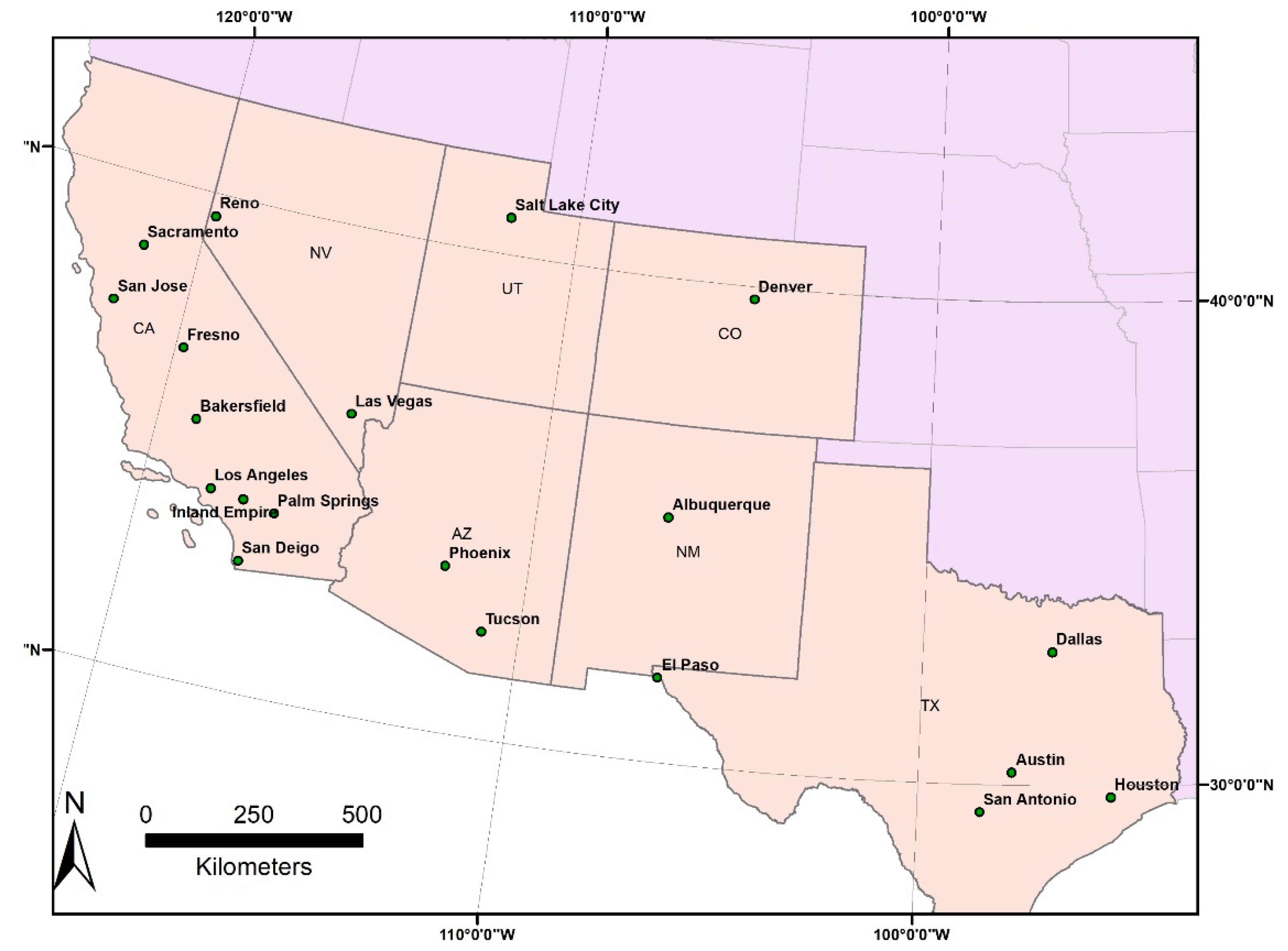
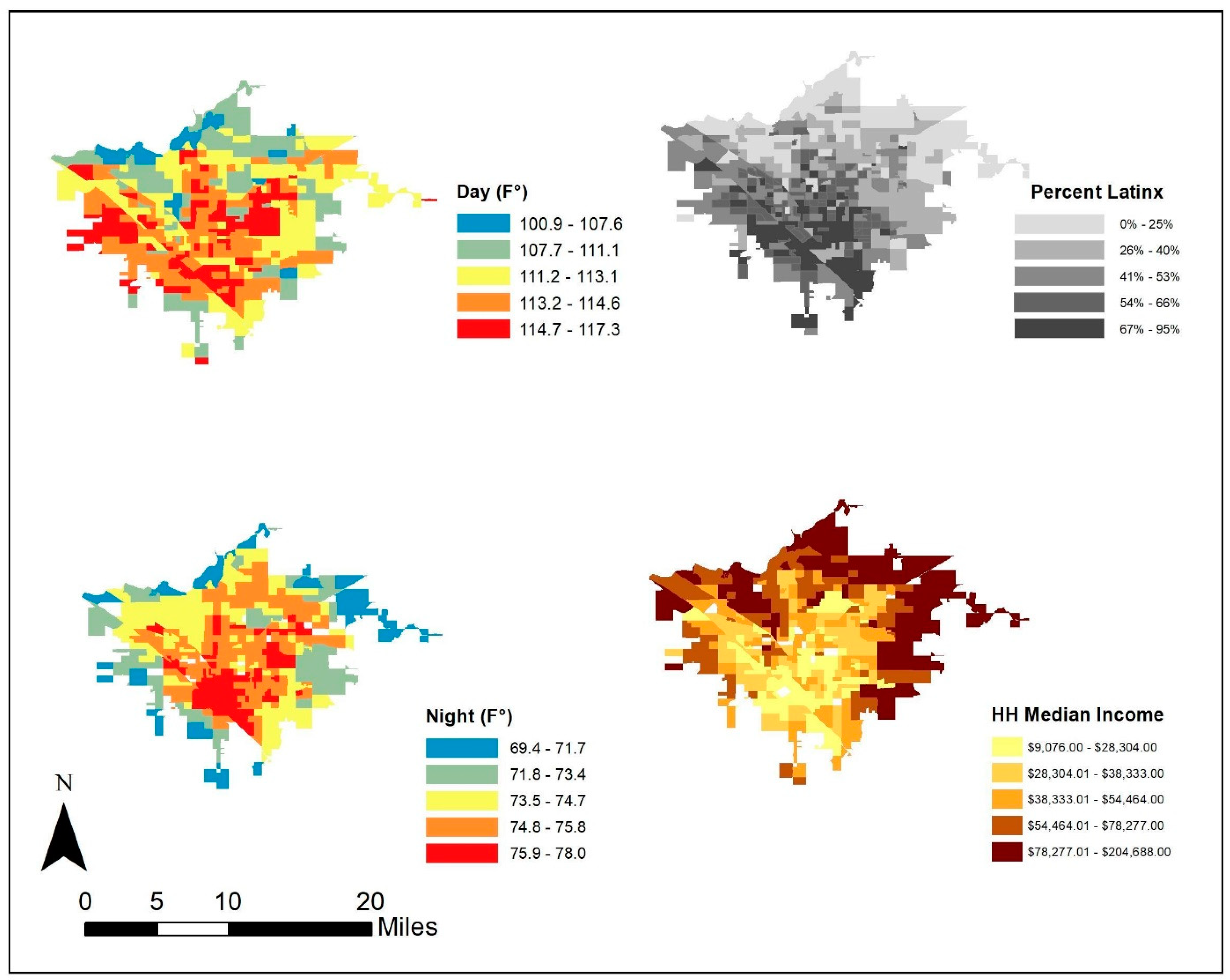
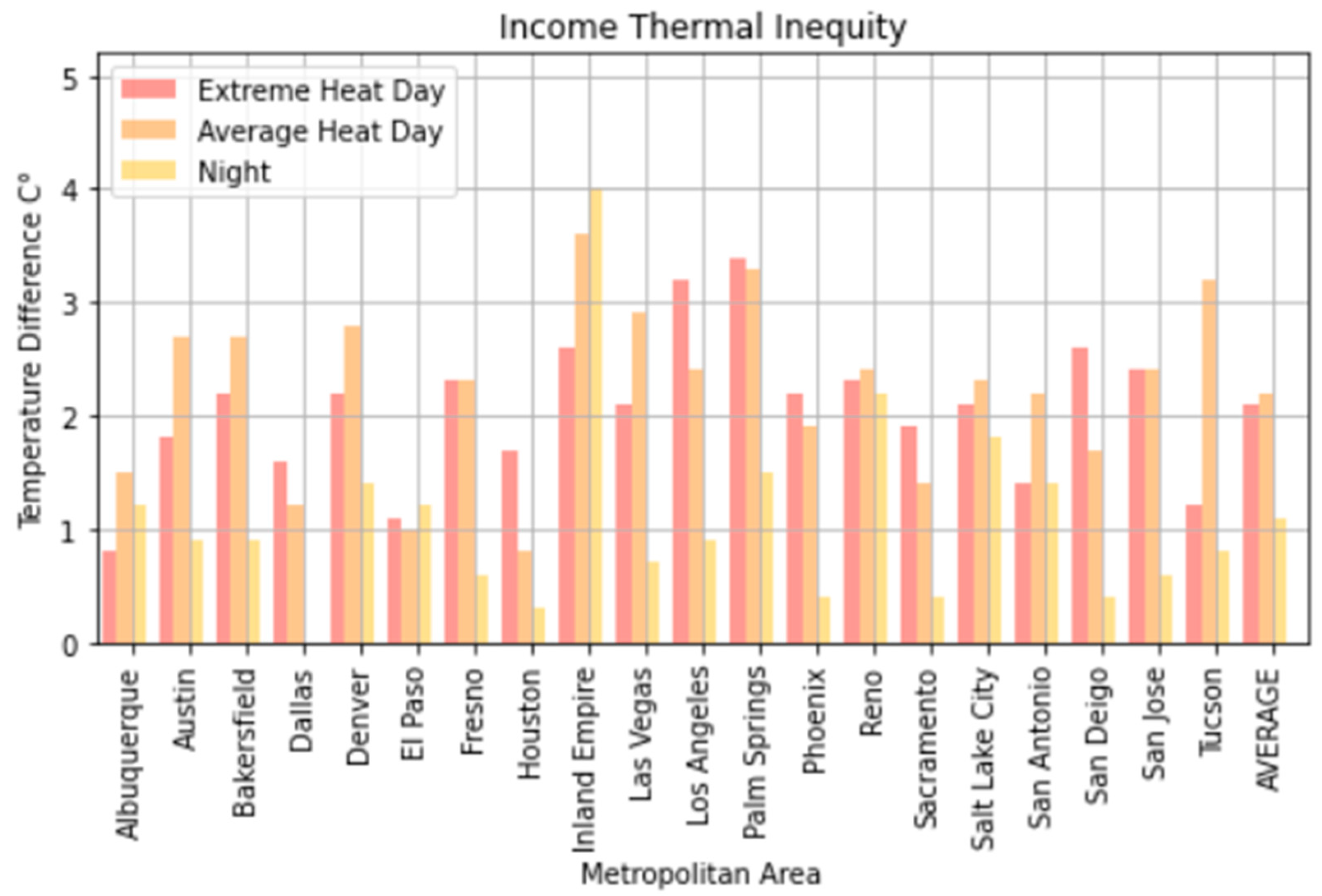
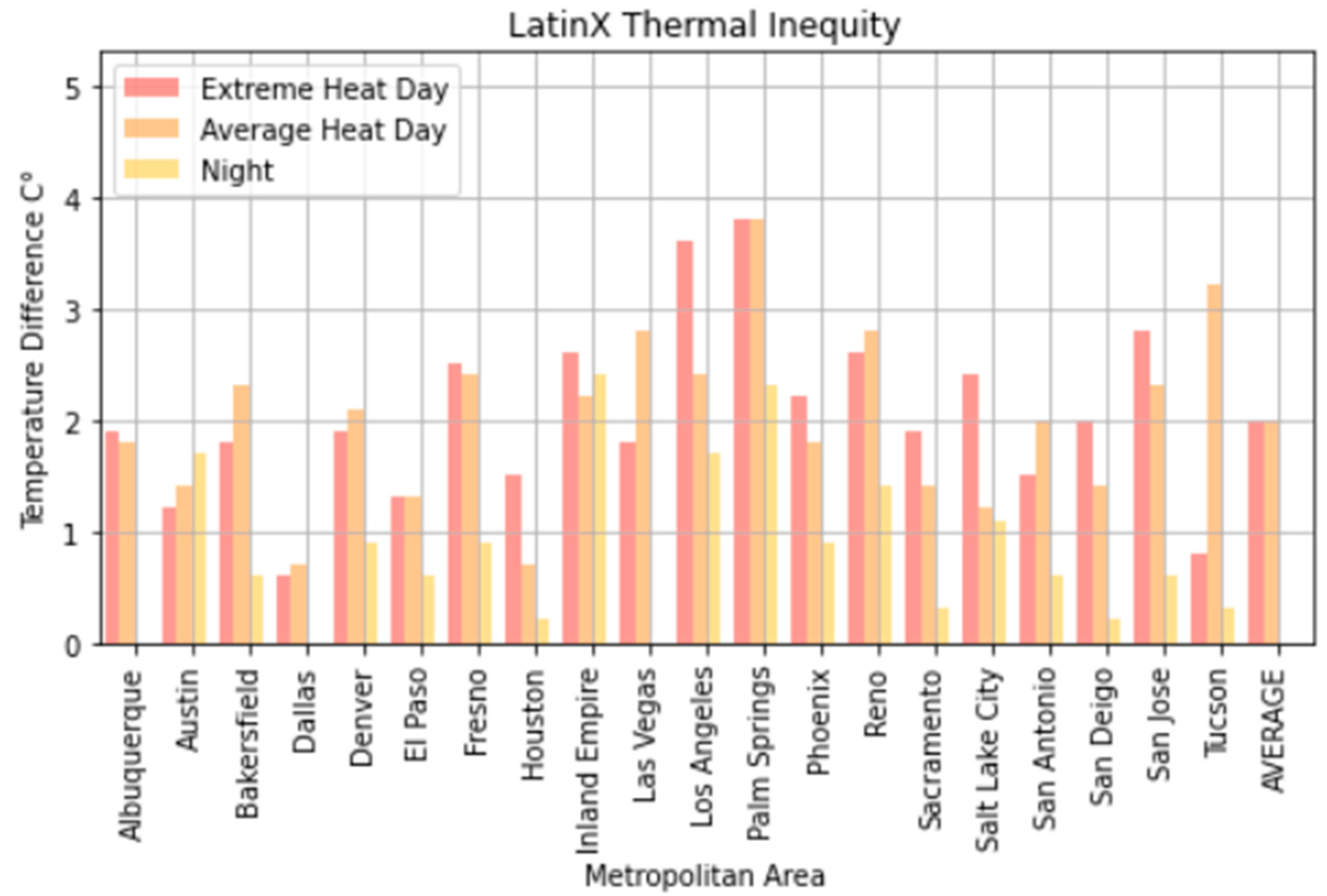
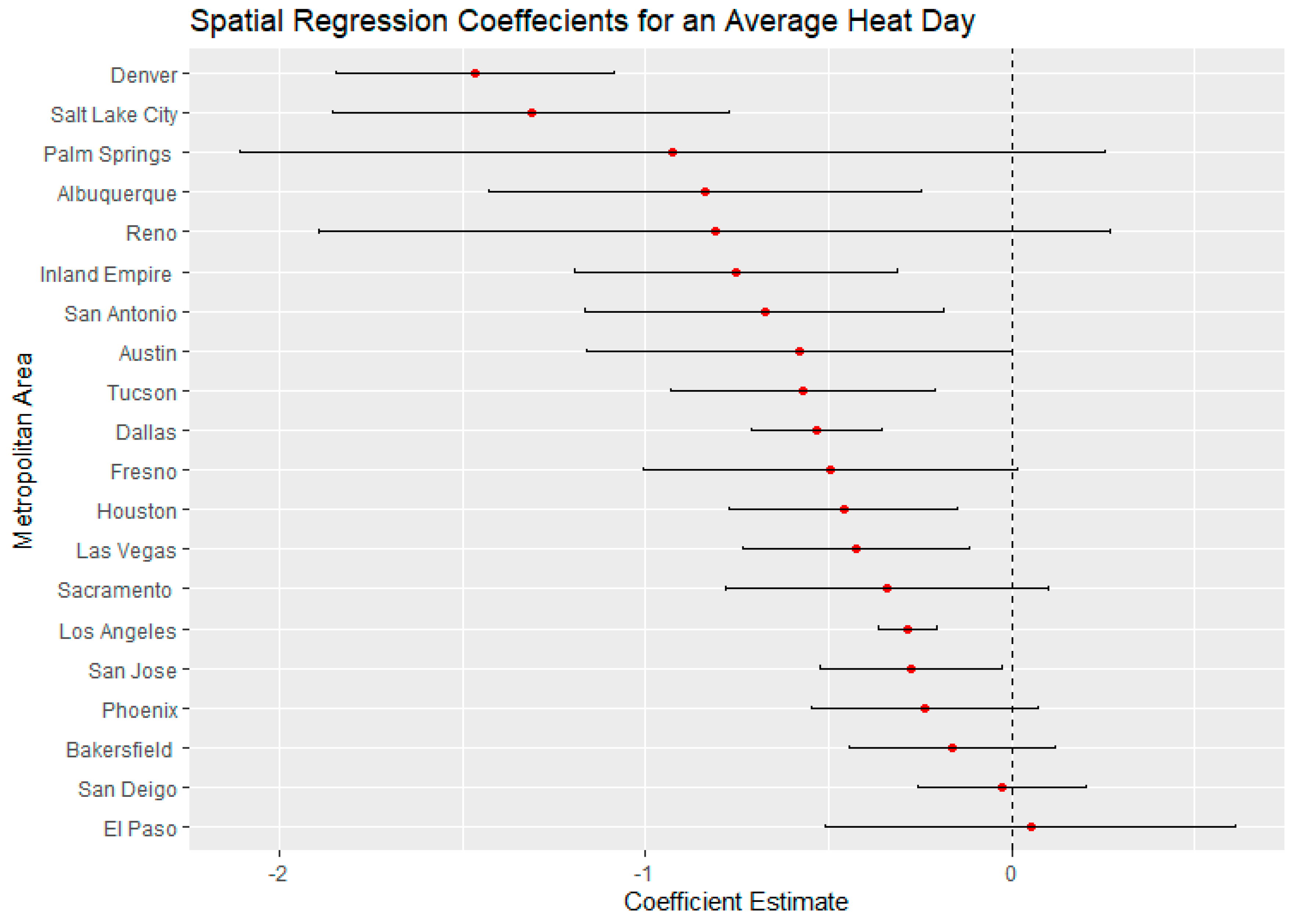
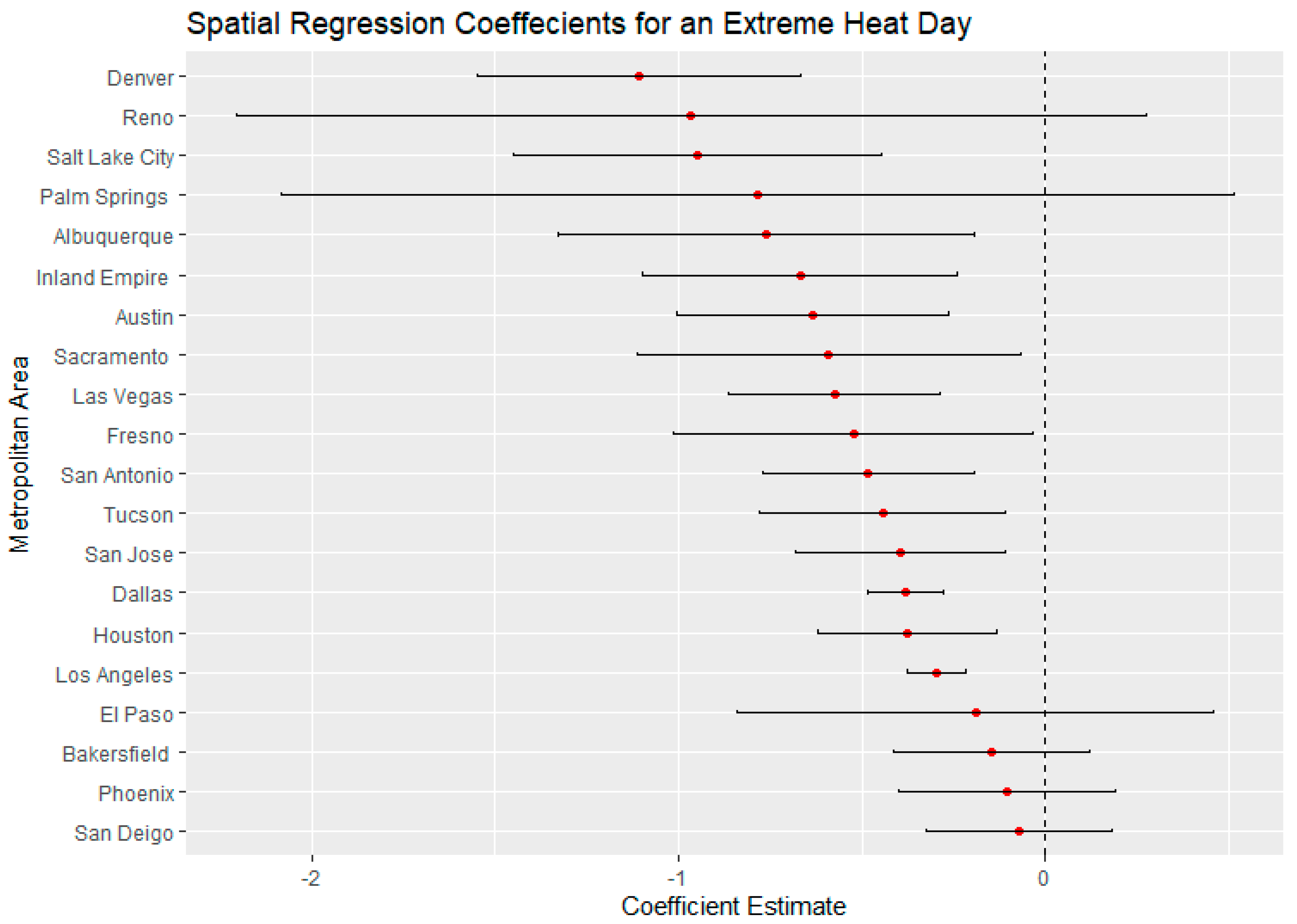
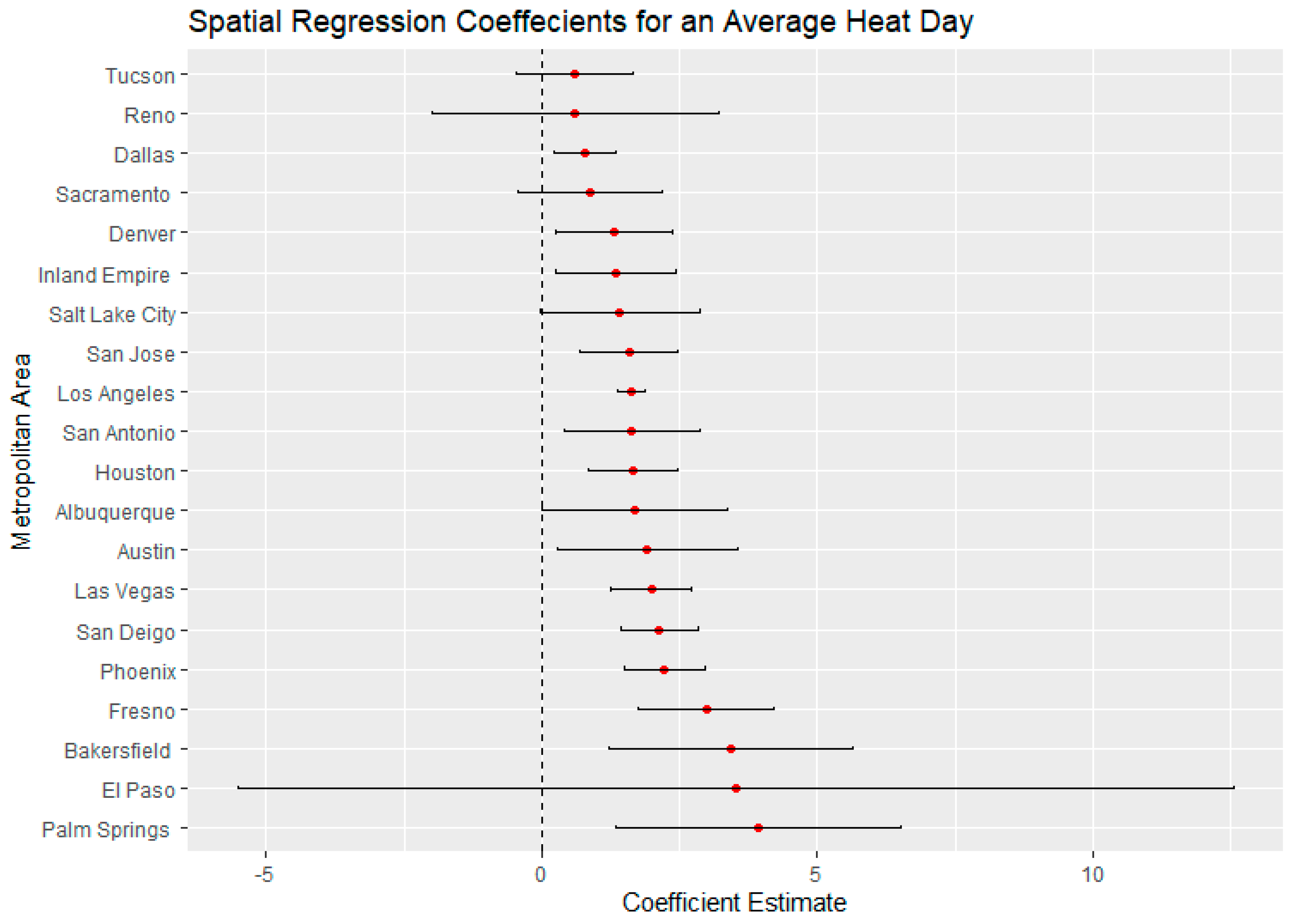
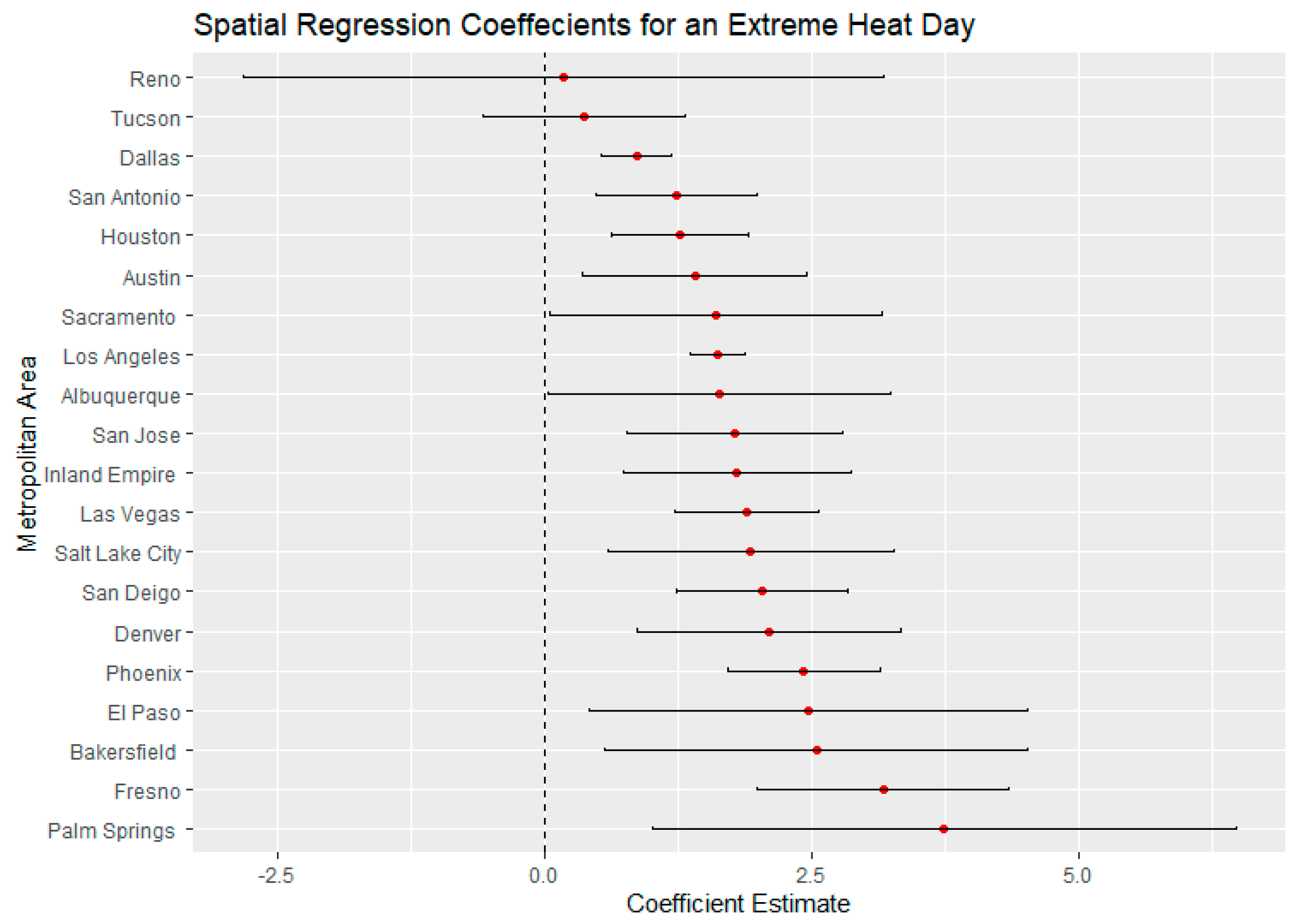
Publisher’s Note: MDPI stays neutral with regard to jurisdictional claims in published maps and institutional affiliations. |
© 2021 by the authors. Licensee MDPI, Basel, Switzerland. This article is an open access article distributed under the terms and conditions of the Creative Commons Attribution (CC BY) license (http://creativecommons.org/licenses/by/4.0/).
Share and Cite
Dialesandro, J.; Brazil, N.; Wheeler, S.; Abunnasr, Y. Dimensions of Thermal Inequity: Neighborhood Social Demographics and Urban Heat in the Southwestern U.S. Int. J. Environ. Res. Public Health 2021, 18, 941. https://doi.org/10.3390/ijerph18030941
Dialesandro J, Brazil N, Wheeler S, Abunnasr Y. Dimensions of Thermal Inequity: Neighborhood Social Demographics and Urban Heat in the Southwestern U.S. International Journal of Environmental Research and Public Health. 2021; 18(3):941. https://doi.org/10.3390/ijerph18030941
Chicago/Turabian StyleDialesandro, John, Noli Brazil, Stephen Wheeler, and Yaser Abunnasr. 2021. "Dimensions of Thermal Inequity: Neighborhood Social Demographics and Urban Heat in the Southwestern U.S." International Journal of Environmental Research and Public Health 18, no. 3: 941. https://doi.org/10.3390/ijerph18030941
APA StyleDialesandro, J., Brazil, N., Wheeler, S., & Abunnasr, Y. (2021). Dimensions of Thermal Inequity: Neighborhood Social Demographics and Urban Heat in the Southwestern U.S. International Journal of Environmental Research and Public Health, 18(3), 941. https://doi.org/10.3390/ijerph18030941






